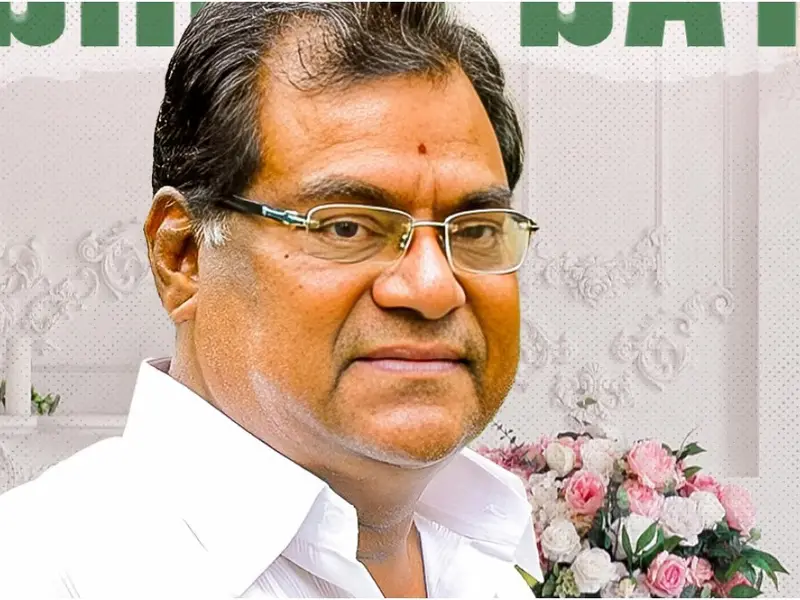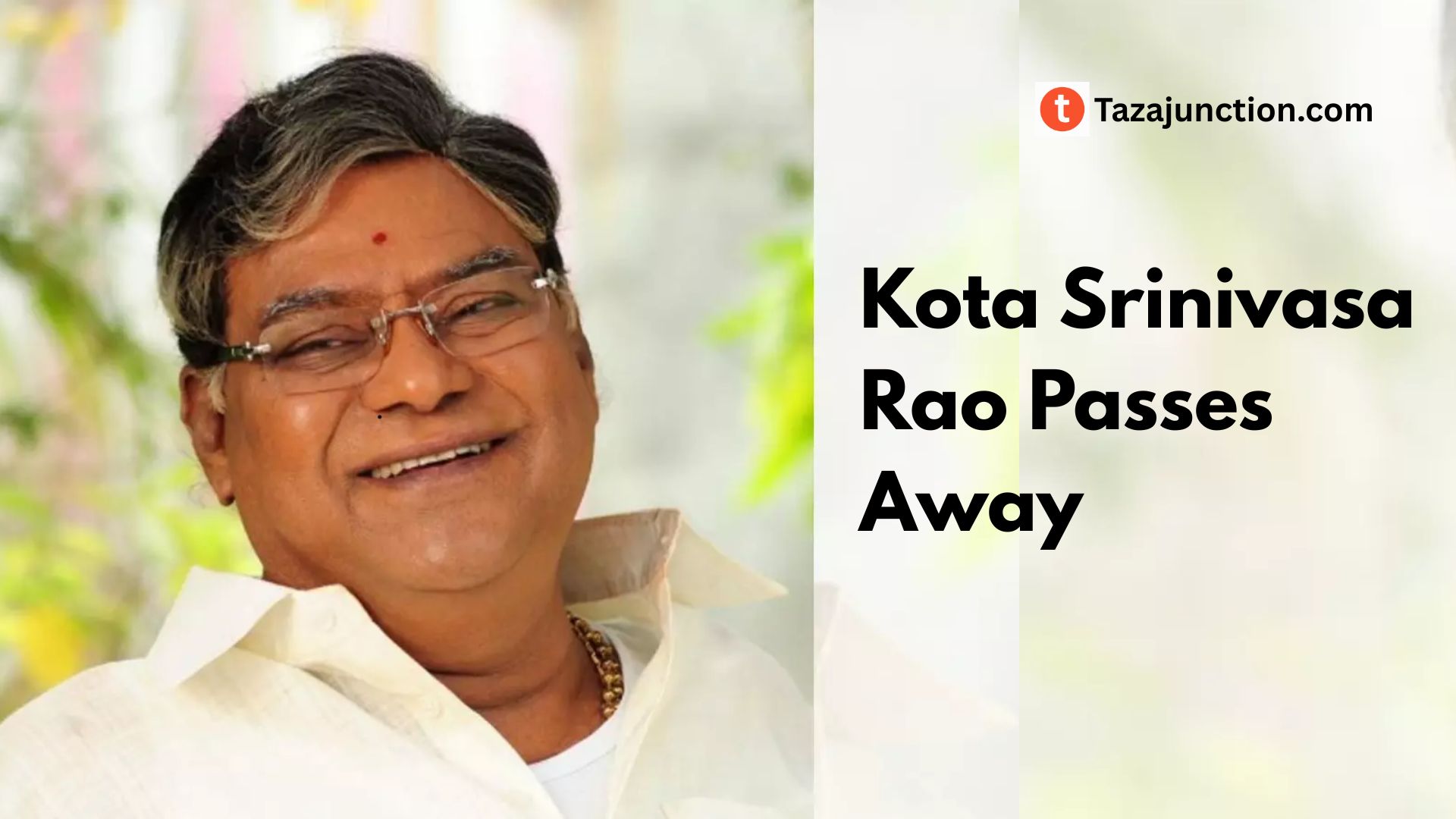On July 13, 2025, the Indian film industry bid a heartfelt farewell to one of its most cherished veterans—Kota Srinivasa Rao. At the age of 83, the legendary actor passed away at his residence in Filmnagar, Jubilee Hills, Hyderabad, following a prolonged illness.
With his demise, Indian cinema has lost not only a prolific performer but also a rare artist who mastered the craft of acting across genres, entertainment and languages. This article celebrates the life and legacy of a man who was much more than a movie star—a cultural institution, a mentor, a politician, and above all, a storyteller.
Table of Contents
Early Life and Background

Born on July 10, 1942, in Kankipadu, a town in Krishna district, Andhra Pradesh, Kota Srinivasa Rao came from a modest background. His father, Dr. Seetha Rama Anjaneyulu, was a respected Ayurvedic doctor.
Young Kota was initially expected to follow a professional path in medicine or banking. He pursued a Bachelor of Science degree and worked briefly in State Bank of India before his passion for acting took over.
Rao’s foray into acting began on stage. He was deeply involved in theatre during his youth, performing in numerous Telugu plays. His deep voice, commanding screen presence, and natural flair for emotive performance quickly set him apart from his contemporaries. Though his family had little connection to the entertainment industry, Kota’s talent opened doors on merit alone.
Entry into Films
Kota Srinivasa Rao made his film debut in 1978 with Pranam Khareedu, which also marked the early screen appearances of another Telugu superstar, Chiranjeevi. This humble beginning sparked a career that would span nearly five decades and include more than 750 films across Telugu, Tamil, Kannada, Malayalam, and Hindi cinema.
Unlike many actors who become synonymous with a single role or genre, Kota carved a unique niche for himself. He was known for slipping seamlessly between roles—villains, comedians, ministers, teachers, and fathers—with equal ease. Whether it was a chilling antagonist or a bumbling yet lovable uncle, he gave life to every character he portrayed.
Master of Versatility
Kota’s real genius lay in his ability to transform into characters that were complex, layered, and often contradictory. His performances in films such as Siva (1989), Gaayam (1993), Pratighatana (1985), and Sarkar (2006) demonstrated his capability to play intimidating antagonists. He didn’t rely on loudness or physical aggression—his calm menace and expressive eyes conveyed far more than words ever could.
At the same time, his roles in comedies like Aha Naa Pellanta! (1987), Money (1993), Hello Brother (1994), and Bavagaru Bagunnara showcased his impeccable comic timing. His dialogue delivery, laced with sarcasm and wit, made him a staple in Telugu family entertainers during the ’90s and early 2000s.
Kota also took on emotionally rich characters in films like Bommarillu, Aa Naluguru, Leader, Athadu, and Attarintiki Daredi. In each of these, he brought depth, vulnerability, and realism to his roles, making them unforgettable.
Pan-Indian Appeal
While primarily known for Telugu films, Kota’s influence extended beyond Tollywood. He appeared in Tamil hits like Saamy (2003) and Anniyan (2005), where he earned praise from critics and audiences alike. In Kannada, he acted in Kabzaa (2023), and in Malayalam, he made an appearance in The Train (2011). His brief but impactful presence in Bollywood, particularly in Sarkar opposite Amitabh Bachchan, also drew acclaim.
His command over language, regardless of region, and his ability to grasp the emotional tone of each film made him a valued actor in multiple industries.
Awards and Recognition
Kota Srinivasa Rao’s contribution to Indian cinema has been widely acknowledged through numerous awards:
- He received 9 Nandi Awards, Andhra Pradesh’s highest honor for cinema, for his exceptional performances in villainous and character roles.
- In 2012, he was honored with a SIIMA Award for his role in Krishnam Vande Jagadgurum.
- In 2015, the Government of India awarded him the Padma Shri, the nation’s fourth-highest civilian honor.
These accolades not only recognized his acting prowess but also his impact on elevating the standard of supporting and character roles in Indian cinema.
A Foray into Politics
In a move that surprised many but made sense given his public appeal and thoughtful personality, Kota entered politics in 1999. Representing the BJP, he was elected as the MLA from Vijayawada East constituency and served until 2004.
During his time in office, he remained committed to social causes and advocated for better cultural funding and development in Andhra Pradesh. Although he returned to films after his political stint, he remained vocal about social issues, particularly those affecting artists and the middle class.
Personal Life and Loss
Behind the scenes, Kota was a deeply spiritual and family-oriented man. He was married to Rukmini, and the couple had three children. Tragedy struck in 2010 when his only son, Kota Venkata Anjaneya Prasad, an aspiring actor himself, died in a road accident. This loss had a profound impact on Kota, leading him to temporarily step away from films.
Despite his personal grief, he returned to acting, perhaps using his pain to add more emotional depth to his performances. He also became an advocate for road safety and youth awareness programs, using his influence to bring about public consciousness.
Tributes and Public Mourning
Following his passing, tributes poured in from across the nation. Prime Minister Narendra Modi called him a “champion of the underprivileged and a stalwart of Indian cinema.” Celebrities like Chiranjeevi, Pawan Kalyan, Vishnu Manchu, and Rana Daggubati expressed their sorrow, calling him a father figure and mentor.
His funeral was attended by political leaders, film personalities, and thousands of fans. Held with full state honors in Hyderabad, it reflected the deep respect he had earned across different walks of life.
Legacy and Cultural Impact
Kota Srinivasa Rao’s body of work has inspired generations of actors and filmmakers. In an era when hero-centric narratives dominated the screen, he carved a space for supporting roles to shine. He proved that an actor doesn’t need to be the protagonist to leave a lasting impact.
His characters were often a mirror to society—complex, flawed, human. From corrupt politicians to wise elders, from conniving villains to loving grandfathers, his range was unmatched. He could deliver a punchline, a moral, or a threat—all with the same authenticity.
He also bridged generations of cinema, acting alongside legends like N.T. Rama Rao, Akkineni Nageswara Rao, and Chiranjeevi, while remaining relevant into the digital era.
Conclusion
The passing of Kota Srinivasa Rao marks the end of an era in Indian cinema. He wasn’t just an actor—he was an institution, a teacher, a servant of the people, and an artist who lived through and for storytelling. His versatility, humility, and unwavering commitment to his craft made him a household name, not just in Andhra Pradesh or Telangana, but across India.
Though the man has left this world, the characters he brought to life will live on in our memories, on our screens, and in the very fabric of Indian cinematic history. For generations to come, students of acting will study his expressions, mimic his delivery, and learn from his life.
As the curtains fall on a remarkable life, one thing is certain—Kota Srinivasa Rao will forever remain a shining star in the vast galaxy of Indian cinema.
Rest in peace, Kota Garu. Your legacy is eternal.

